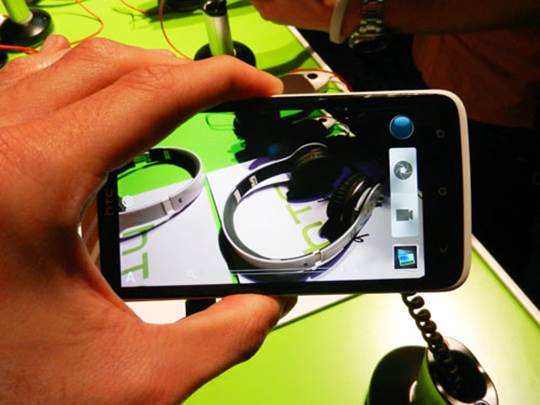Beats audio
We need to manage another important aspect
of this phone’s audio output: Beats. If you used to read our review about HTC
Sensation XE, which is the first phone accompanied by Beats Audio, you will now
that we were not bothered much by it. Just like the tests that we conducted in
2011, it is basically the S-shape EQ setting; it exaggerated the audio
frequency, the particular bass and increased the volume in general. All of
those are enough for the audiences to experience a wonderful effect with the
right music type, but the similar effect (or even better) can be achieved with
any of good music players for Android. However, things have changed as time
goes by, and what we saw on One X+ is so different. First of all, it can be
activated of disabled no matter what earphone plugged in the 3.5 mm headphone
jack. The marketing is also somehow improved. There are still many distorted
claims, for instance the claim, which is not understandable, that beats
provides the “studio-quality sound”, but at least HTC has no longer
concentrated on Beats as a special feature, and it also clarifies what Beats
provides – for example, “deeper bass” and “crisper vocals”. The most ironic
thing is here: despite the rational marketing, it is for sure more useful on
One X+ than before, because it is accompanied by the heavily increase of the
volume: in other words, the maximum volume level is much higher than the
activated Beats, whereas it increased much lower before (on One X for
instance). As long as you can suffer the exaggerated frequency coming with it, which
might be a huge help if you wish to play music through the over-ear cans with
the above-average level impedance.

HTC
One X+ and its Beats headphones
Camera
The most considerable improvement of One X+
is definitely the front camera. The difference is not made up by the higher
resolution; in reality, the final image is still 1,289x720. The power of this
camera is in the sensor quality and the image editor, which turn it into a
wonderful device for video chatting and portrait picture capturing. The above
pictures say our words, and the picture on the right hand side is not only
clearer and more detailed but also captured the more natural pose thanks to the
new 3-2-1 counting down feature of One X+.
According to HTC, the rear camera did not
improve at all – we have not ever seen any similar module like One X. However,
since it has taken so many shots and video side by side by 2 different phones,
we thought that One X+ has a little more advantage thanks to its processor. In
the burst shot mode, One X+ takes 20 shots just in 3 seconds, while One X takes
5 seconds. When starting filming the video, One X+ is 1 second faster and its
autofocus also seems to be faster too.

Picture
captured by the One X+
Of course, the faster speed will not give
you better quality, and even in this aspect that we found One X+ so
disappointing, just because it has not fixed any of its flaws that appeared in
One X. First of all, there is still no way to lock the exposure and to focus
before re-framing a shot. This is a big problem because it will be very hard
for you to control the unusual exposure – in reality, when trying to capture an
identical side-by-side picture with One X and One X+, we were almost impossible
to get the same exposure and focus on both cameras. The reason is not this is
better than the other one but both seem to work mainly on luck.

Of
course, the faster speed will not give you better quality, and even in this
aspect that we found One X+ so disappointing, just because it has not fixed any
of its flaws that appeared in One X.
Another problem: the video transferring
speed has not been improved at 1080p, even though we get better processor here,
with more space in the internal storage. We filmed a high-detail scene to show
this – it was completely torn because of the compression acts. Galaxy S III
higher video data speed. That does not count the two-stage stills shooting
feature, and the result was that we still insisted this phone (with Note II)
has more excellent camera in all aspects. The life-saving point of HTC is the
low-light performance, which benefits much from the quick f/2.0 lens, but
somehow distorted by the anti-noise filter which ruins the details of HTC.